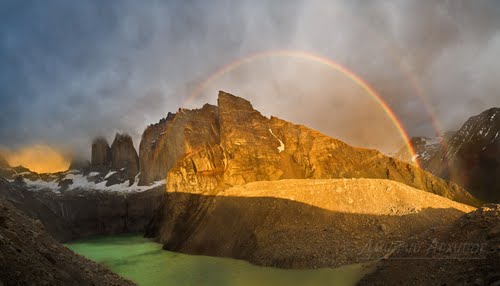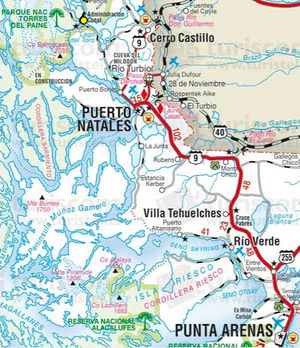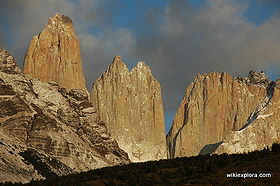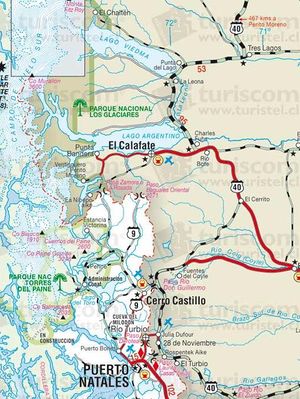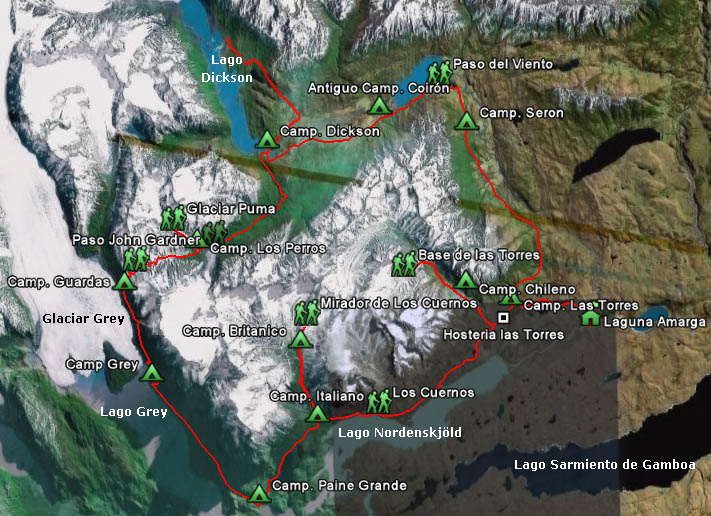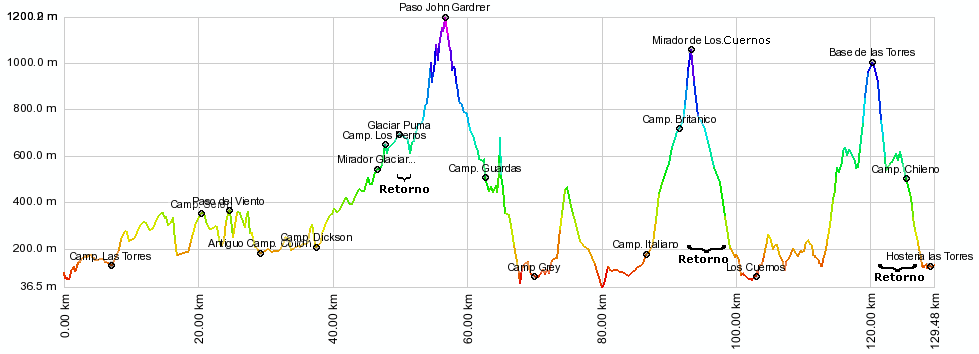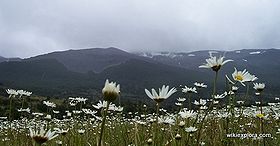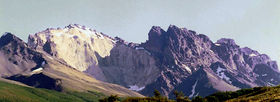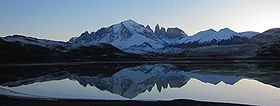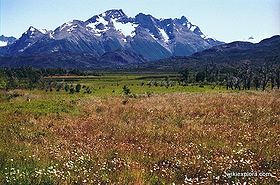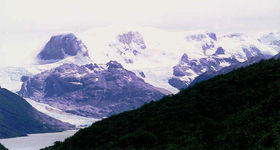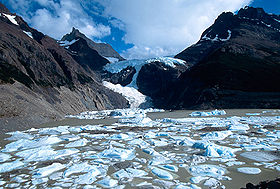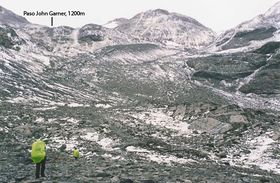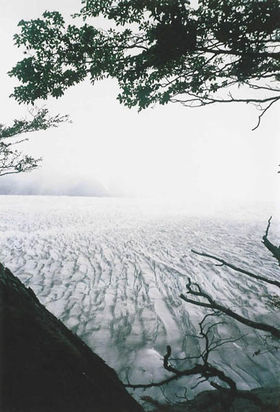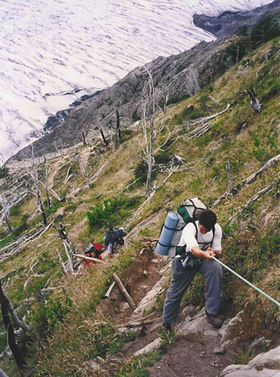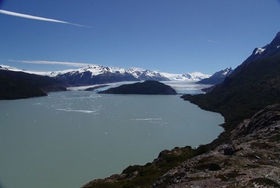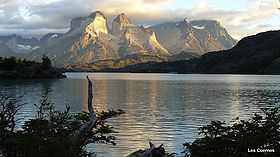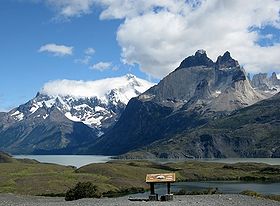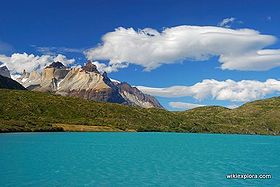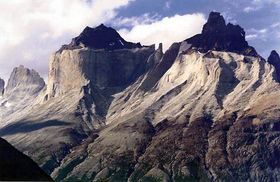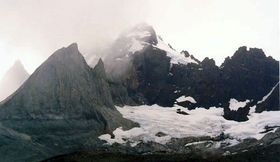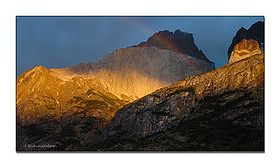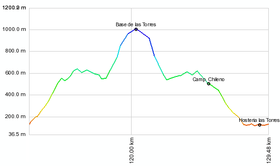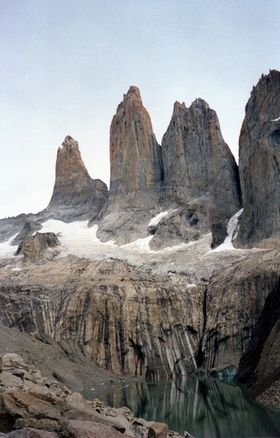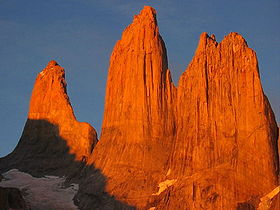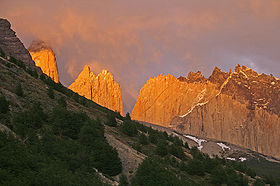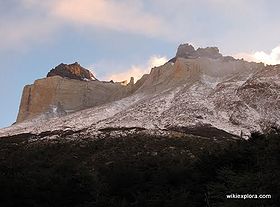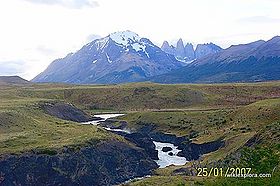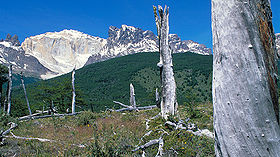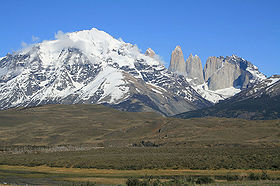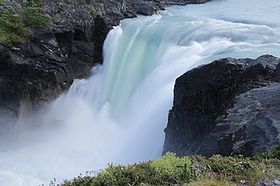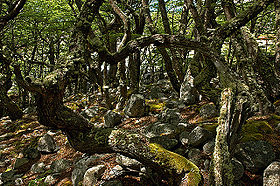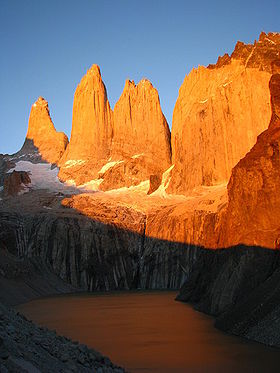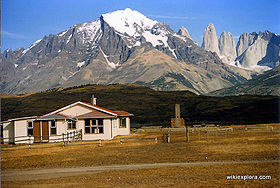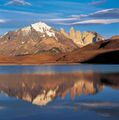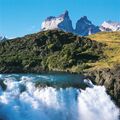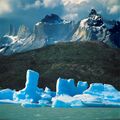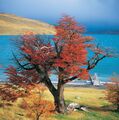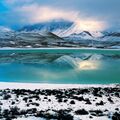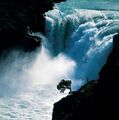Diferencia entre revisiones de «ENG:Trekking Torres del Paine»
| Línea 20: | Línea 20: | ||
|KMLZ=Trekking Torres del Paine.kmz | |KMLZ=Trekking Torres del Paine.kmz | ||
|ComentariosMapa= | |ComentariosMapa= | ||
| − | <span style="background-color:#808080; color:RED">'''Red:'''</span> Section shared | + | <span style="background-color:#808080; color:RED">'''Red:'''</span> Section shared with [["W"_de_las_Torres_del_Paine_english|"W" circuit]]<br> |
| − | <span style="background-color:#808080; color:blue">'''Blue:'''</span> | + | <span style="background-color:#808080; color:blue">'''Blue:'''</span> the rest of the circuit, not as popular <br> |
<span style="background-color:#808080; color:YELLOW">'''Yellow:'''</span> alternatives to Dickson glacier (described below as an aditional day), the hike to [[Mirador Zapata]] and the walk from the park entry (CONAF post) to Paine Grande Camp (see [["W"_de_las_Torres_del_Paine_english|"W" circuit]])<br> | <span style="background-color:#808080; color:YELLOW">'''Yellow:'''</span> alternatives to Dickson glacier (described below as an aditional day), the hike to [[Mirador Zapata]] and the walk from the park entry (CONAF post) to Paine Grande Camp (see [["W"_de_las_Torres_del_Paine_english|"W" circuit]])<br> | ||
<span style="background-color:#808080; color:WHITE">'''White:'''</span> roads<br> | <span style="background-color:#808080; color:WHITE">'''White:'''</span> roads<br> | ||
Revisión del 17:27 3 oct 2014
Introduction
' 'Trekking Torres del Paine' is one of the most spectacular treks in the world. In fact, according to a review of 9 specialized books that make their own selections of the best routes in the world, Torres del Paine is the most frequently named (you can see the study in Best Treks / Hikes of the World, top 100). For this reason, it is extremely popular, and it is very advisable route in November to early December to avoid the massive January and February.
Before starting, please read the Suggested itineraries, to decide what is the best way to make your days there. You can also train you a general idea of [[Torres del Paine] National Park].
Note that although this route is located in Patagonia, famous mythical so remote and so hard on your climate, this is a low altitude trekking and with very good infrastructure, so it is a business that anyone with good fitness can perform, with or without experience.
That said, if you have no experience in trekking, it is especially important to pay attention to the advice on equipment and food: it is very common for inexperienced people who rush to finish this hike suffering to carry food or equipment too heavy, or poor quality. While it is a challenge that anyone can take, you can not just bring the family pot half kilo of your home, a solid stove designed for camping car or those zapatones more oriented to industrial work than walk 7 hours day.
And now, enjoy!
Best season
The proper time for this route is between November and March. Ideal is November and December, when the weather has improved, the days are long and there are so many people doing the circuit as in January and February. Winter is a beautiful time, but the circuit is too lonely for these months, it is more advisable to try and ' The "W"' or, and far less ambitious, content with the 'Base of the Torres del Paine' .
Access
From Chile (Punta Arenas)
To get to Punta Arenas there are three options:
- Airway: There are daily flights from Santiago to Punta Arenas. The trip takes about 4 hours and if it's clear you can see from the air the Patagonian fjords, ice fields and the Torres del Paine themselves.
- Sea: There is a 4 day trip highly recommended, either from Puerto Montt to Puerto Natales or vice versa. It takes you through the wonderful maze of canals and the Gulf of Penas. It passes by Puerto Eden, a small village inhabited by fishermen and refuge of the last alacalufes, and also a starting point to the impressive glacier Pio XII.
- By Land: The journey takes 36 hours between Puerto Montt and Punta Arenas, but it is the cheapest option. It lets you know the pampa and its estancias, where the huge distances have shaped the character of this region.
Depending on the amount of time availabe and on your resources it is advisable to combine different means of transport to get in and out of Patagonia, thus to get a fuller view of the region.
By car
From Punta Arenas there are 254 kilometers by paved way to Puerto Natales. From there, there are two options:
- Old road through Cerro Castillo: Continue to Cerro Castillo, 60 km of paved road. Once in the village, turn left (west) and continue along a gravel road. 44 kms later there is a bifurcation: two roads lead to the park. Take right. After an additional 9 kilometers (113 and 367 from Puerto Natales from Punta Arenas) the CONAF (ranger) post of Laguna Amarga is reached.
- New road to Villa Serrano: From Puerto Natales, advance 16 kms along the old route (towards Cerro Castillo) to the turnoff to the left that leads to the Milodon Cave. The cave is reached after 7 kilometers of road gravel. Since the cave, there is a stretch of 65 kilometers of gravel until the administrative center of the park, at Villa Serrano. From there, continue along the gorgeous main road of the National Park, which 39 kilometers later reaches the CONAF (ranger) post of Laguna Amarga
Public transport and hitchhiking
All phones with codes 56-61
It may seem unbelievable, but there are no direct buses from Punta Arenas to the park, so you have to stop in Puerto Natales. As the second and final trip to the park from Puerto Natales is at 14:30, from Punta Arenas to Puerto Natales you can take the buses that leave at 8:30 and 10 to arrive before 14:30 and get to the park on the same day (it takes about 3 hours between the two cities).
Buses from Puerto Natales to Torres del Paine National Park will leave you at Laguna Amarga. From that point, it's about an hour of additional hike along the road to Hosteria Las Torres, the usual start of the trekking. This last stretch can also be done in minibuses that wait for the arrival of the buses from Puerto Natales.
Punta Arenas - Puerto Natales
- Buses Pacheco ($ 4,000, $ 7,000 roundtrip)
- Frequencies: daily from Punta Arenas: 8:30 - 10 - 14 - 18 - 19:30 hrs.-
- Heads back at 7.30 - 10 - 13:30 - 16 - 19:30 hrs.-
- To corroborate schedules: here.
- Punta Arenas: 900 Avenida Colon T: 242174 and 241162
- Puerto Natales: Ramirez 224 T: 414800, 415123, 414800
- Buses Fernández ($ 5,000)
- Frequencies: daily from Punta Arenas: 8-9 - 13 - 14:30 - 17 - 18:30 - 20
- To corroborate schedules: here
- Armando Sanhueza 745
- T: 221429
- Bus Sur
- Frequencies: daily from Punta Arenas: 9 - 15 - 17 to 19 hrs
- José Menéndez 552
- T: 614224-614225
Puerto Natales - Torres del Paine National Park From Puerto Natales, between December and February there are two buses a day to the park, at 7 am and 2:30 p.m.. In November, March and April the are only buses that depart at 7am.
- Bus Sur: Baquedano 668 T: 614220-614221
- Tourismo JBA Patagonia: Prat 258, 412 824
- Buses Gomez Prat 234-A. T: 415700 ($ 12,000 round trip in January 2009)
- Bus transfer: Bulnes 518 T: 412 616
- Buses María José: Esmeralda 869 T: 410951
Torres del Paine National Park from El Calafate, Argentina
By car
From El Calafate, it is 284 kms to the border in Río Don Guillermo, close to Cerro Castillo. From there, it's another 58 km. of gravel road to the CONAF post at Laguna Amarga, in Torres del Paine National Park.
El Calafate, in turn, is located 215 kms south of El Chalten, the other trekking hot spot of the region.
Public transport and hitchhiking
Tourism Zaahj drives the route El Calafate - Cerro Castillo - Puerto Natales. Get off the bus at Cerro Castillo and wait for the buses described in the previous section coming from Puerto Natales.
Schedules
- Tuesday - Thursday - Saturday: 8:00
- Monday - Friday: 16:30
The trip takes 5 hours to Puerto Natales, but it depends on the immigration control in both Argentina and Chile.
Office El Calafate:
- Bus Terminal, Office 07, El Calafate, Argentina.
- Phone / Fax: 54-2902-491631.
Torres del Paine National Park opening times
Office hours in Sarmiento and Laguna Amarga: 8.30 to 20.30, all year round.
Transportation from CONAFpost in Laguna Amarga to Hosteria Las Torres (start of the trekking)
To get to the lodge there are two options: walk 7 km by road vehicle (1.5 hours) or take a transfer of $ 2,500 / ea. There are also good options to hitchhike if traveling in a small group.
Description of the route
The Paine Circuit is a walk of 8 day trek effective (rising to 9 if done well at Dickson Glacier trekking). Typically make the circuit in the opposite direction to clockwise, and take two branches of a major full day (French Valley and Las Torres) and a branch of a couple of hours (Glacier Punta Puma)
The following image shows the altitude profile of the route. It is noted that this is a trekking generally of low height, which does not mean that, given the harsh climate of the place, mountain conditions can occur even in the summer months.
Day 1: Hostería Las Torres - Serón
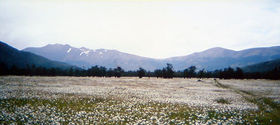
'Note: This review this stretch has been designated as day 1, but can also be the 2nd if it is decided from the first day to the base of the Towers, 8th marked here as' .
Behind the lodge "Las Torres", near the path starts the circuit of Torres del Paine. A little more than 100 meters the first sign that shows the path towards the camp appears Seron. You must climb a small hill and then cross a wooden barrier (please close them once crossed, like all others). The trail traverses an open, uncluttered area with scattered trees (especially beech and notros). From this point, it will fail to appreciate Mount Almirante Nieto (2,640 m), which dominates the area of Las Torres.
After a gutter rock appears Amarga lagoon, the entrance to the National Park and the vehicular road to the area of plains low rise with a more stable and drier than the western park, whose tallest traps moisture from the Paífico . Behind us we can see, in the distance, Mount Balmaceda (2,036 m), in case that is not covered by clouds. After about half an hour a second trick to start walking through a wooded area, where he soon another signaling and a fence that runs parallel to the path we have been following is cross appears. Fifteen minutes later a small cross slope is provided with a wooden bridge. Continuing along the path, it will enter and exit the forest cyclically twice more.
After about an hour of walking, a new signal is shown. From this point, we can see Blue Lagoon in the distance, and the Paine river in the lower valley. Now it will be seen more clearly in the whole area of the northeastern shore of Paine (the opposite bank of our footprint), the effects of the fire that broke out on February 17, 2005.
You after the hour and half walk, you pass over a second stream, which is opposite the Blue Lagoon and good view of the valley of Paine, the river that gives the park its name. The trail then circles the hill Paine (1,508 m., Not to be confused with the Paine Grande of 3,050 m and the "three thousand" southernmost of America), whose slopes contain lots of burned logs due to frequent fires of the twentieth century. Forward will be a major creek, to which gently down the path, and it brings a significant amount of water. Follow a new wooden barrier, and then the trail descends to an open area with some ñirres the sides.
It was later lowered to a confluence of two paths: we have been following and next from Laguna Amarga. There's a new poster and a locking bar. A wide, flat terrain to traverse along the Paine River, beautifully covered with daisies and some other isolated clumps or ñirre. After 20 minutes you come to a gateway rustic log railings provided with a rope. When you get closer to the river, there will be a forest of ñirres.
Shortly before Seron be exceeded a fence. The track passes through a hill slope where the river reaches the last point before reaching the site. There is a stream with clean water, several picnic tables next to put a stay and a small warehouse.
Seron campsite is paid: $ 4000 p / p.
- Total expected time for this section: 3h 20'
Day 2: Serón - Dickson
From Seron must advance 200 meters parallel to a fence, then cross it. Even walking through the meadow of daisies and occasional ñirres. It will continue along a marshy area to the right of the path. After about 25 minutes, pass through a stream that flows into an input of the Paine River. Then the trail climbs along the river and becomes more rocky, while the first neneos arise, curious plant a shrub with a rounded form, as well as some calafates (possibly without its famous fruit, due to the frequent passage of walkers). After 250 meters, it will be possible to observe a lagoon with characteristic kidney shape, at which point there is a sign indicating the route. It should then start a zigzag ascent by a section of carries to 400 meters of altitude, in the so called "Paso del Viento", whose name is well earned. At that point, the trail bends to the west, allowing Paine observe the lake in its entirety. From this point, you enter the more wild and mountainous area of the park, and the path forward is seen: the way Coirón, camping Dickson Glacier Los Perros left and the valley leading to Paso John Garner. To the right, away from the road, Mount Ohnet of 1,929 m can be seen. Going down the path along the lake Paine. In half of the decline is a small shed. After the second half of the lake, progress is retarded by fluctuating ups and downs.
He spent an hour and a half from the Windward Passage, arrive at a camp in the old sector Coirón. The place is deserted, devoid of natural attractions and is very close to Seron, making it a bad choice for camping. There is a small stream. Ten minutes later, we reach the stream coming from waterfall visible upslope. It then continues along the hillside, past a marshy area on the right. You can now see more clearly the Los Perros Glacier, Glacier and right Dickson, one of the many huge drains eastern Southern Ice Field, under Cube Daudet and mountains. What follows is a flat stretch, with some minor hills. Near the lake you can see Dickson LEFT Torres del Paine-the unusual view from the north, and to the left of Oggioni (1,697 m.), The Central Tower.
This area is populated by markings stakes, whose sides are numerous traces of the twentieth century made fires to clear grasslands for livestock. About two hours after Coirón is up at the foot of a hill where there is an abandoned building, in a marshy area. Only half an hour later you come to Dickson.
The camping Dickson is paid: $ 4000 p / p.
- Total expected time for this section: 5h 40'
Optional day: Glaciar Dickson
First, it is necessary to cross the river in a zodiac, available in the summer months, and that should get in the shelter, and which must be paid (HOW MUCH). A flag in place giving notice of leaving trekkers. Once on the other side, should rebound somewhat the slope to get on the path leading to the lake Paine. To the left is a hill and right the Paine River. The trail continues north around a rock plateau located to the left and out into an open field. One can observe the unusual north face of Torres del Paine and the cord that leads to Paso John Garner (and will face two more days).
After 30-35 minutes no stakes perpendicular to the left of the road, traces of an old fence. A sign on the ground indicates to "police". At that point you should turn left and continue parallel to the stakes ENFORMA towards the Dickson glacier. The trail is fuzzy on this stretch, so it is important to pursue by road with slope, near the old stakes or oranges. To the left is a rock plateau. Then he will enter a wooded area and cross a stream in a little while. After 10 minutes the trail turns to the left, towards a gorge, where a portezuelo. But our route ascends a hill and then goes through the side of a cartage.
After half an hour and you get to Quemado Lake (300 m) east of Lake Dickson, in an environment marked by ancient fires that slowly recovers. The trail goes up and down several times. After a half hour from the Quemado Lake was reached, we return to an area of mature forest, not destroyed by fire. The footprint is here marked with orange color. There are wooden bridges and walkways built by police. As the forest is left the glacier appears. It goes through a swampy area and then come to a small hill to the left, which recommends up to take advantage of its magnificent view.
About 15 minutes later, after passing another forest with streams and bridges, the trail climbs to an open space where the police advanced seal that covers the border area adjacent to Southern Ice Field is located. A few minutes of catch is the splendid viewpoint Dickson, where besides the glacier mountains Daudet and Cube will be observed.
- Total expected time for this section: 2h 55' de ida, 2h 30' de vuelta, más el tiempo del cruce del río.
Day 3: Dickson - Los Perros
It starts with the path marked by a flag, which leads to a dense beech forest composed mainly, but also coigües Magellan and notros. After 15 minutes you will be back to Dickson Lake and the glacier of the same name at the bottom. At 350 meters you must cross an old fence. Then be followed by more mature forest, crossing a while a wooden walkway.
Before penetrate inland, becoming a great open view with a place mallín (flooded area). There is a small hill with good visibility. The trail turns left along the mallín and then descends to the Indian Head River, where a gateway logs. The track then climbs a muddy area and is internal to the southwest by Los Perros river valley. After about half an hour from the Indian Head will be a waterfall. The trail continues next to the river, with small slope, in the shadow of the Fagaceae of the place, interrupted by occasional fallen trees and frequent streams of fresh water.
Two and a half hours after the waterfall up a suspension bridge crossing the River Dogs. At this point becomes visible Glacier Los Perros. The trail climbs the moraine in a stretch where the trail is lost a little. After 15 minutes the top of the moraine is reached, where there is a beautiful view of the glacier and its lagoon, usually populated by floating ice. We also see the route to "El Paso". Then be followed by the moraine. The campsite is located Dogs into a beech forest at 540 m. There is a store, restrooms and fire, and must pay $ 4,000 p / p.
- Total expected time for this section: 4h 20'
Ramal alternativo a Glaciar Punta Puma
Dogs From the campsite, you must exit the track that leads to the passage, even crossing the river by the bridge, but after this, continue right along the river O'Brien instead turn left towards the Paso . You walk by the river by a space devoid of vegetation. When you can no longer continue on this course, you must enter the forest. The footprint is blurred and no signs, but suffice it to move parallel to the river under the shade of a dense forest of beech and coigües Magellan. Then he will move up a hillside and the river will be visible down encased in a sector. After about 25 minutes, you will reach an area of scrubby vegetation growing on the moraine, from which point the Punta Puma glacier is already visible. Then you have to cross a small barrier of loose stones before mounting on rocky terrain devoid of vegetation. Striking an isolated clump of young beech. The remaining distance to the glacier is a path of little slope. After an hour of walking and 750 meters altitude glacier ice is reached. The lower end is covered with rocks and falls with a gentle slope to the valley, but you can walk a little about it to an area of white ice. This branch is advisable to go early if you have arrived at the campsite Dogs (before 16) but in any case it is recommended to allocate a full day to it.
- Total expected time for this section: 1h de ida hasta montarse al glaciar, 45' de vuelta
Day 4: Los Perros - Paso John Garner - Guardas
It is the hardest trekkig day. From the campsite Dogs, continue down the path across the river by the footbridge. Then you must turn left, heading towards the Pass. The footprint has been identified in the trees some distance. Then they must pass a swampy area (it's the only part that really justifies trekking gaiters) that will last for the next hour walk. There are some open areas with good views.
After an hour and a half, to 760 m footprint approaches the river Paso, you have to cross guided by the orange markings on a narrower section. It is important to get to the place, because it is not easy to cross at other points. The trace its rise on the other side persists, leaving the mud. Now it is usually windy and rocky terrain, typical of the mid-mountain. Now the orange markings are on the rocks. From several hundred meters below the pass, it becomes likely to find snow even in the summer months. And if rain is forecast in this area is likely to fall snow.
Step John Garner is 1200 m., 1 ½ hours later that the river crossing, and allowed to cross the massif of the Cordillera del Paine to the western sector of the park. The views of the Southern Ice Fields and Grey Glacier is spectacular, so, coupled with the possibility of snowfall described, it is very advisable to do in good weather. There are orange rods that serve to guide the way when the weather worsens visibility. The descent follows a moraine, and always with beautiful view. One can appreciate the retreat of the glacier: the old nunatak is now a peninsula, and has recently appeared one second nunatak. After 15 minutes of descent, 950 m., Becomes the first glimpses of vegetation, with some beech dwarfed and bent by the wind. As you walk through the forest, the glacier is visible through the branches. The descent is steep and difficult, quite steep.
A 550 m. and after just under 2 hours descent you reach an old camp sector, rather narrow, nestled among the trees, as indicated by sign "Camp El Paso." Should continue in a southerly direction parallel to the glacier. There are some aspects with large beech. After 40 minutes from the previous point, you get to camp El Paso, located in a narrow sector along the trail and a creek. There is a small bathroom and an open container that serves as a shelter and natural gathering place for campers. It is a place with no services or bathrooms, but it's free.
- Total expected time for this section (untill El Paso): 5h 45'
'Note'
From this point (which in this review are listed as 5 and 6) how to distribute the day is not as clear as on days 1 to 4 Day 7 clearly be to Hosteria Las Torres but may vary starting point. Day 8 (which can also be 1) is almost fixed too (except for those willing to follow the Valley of Silence, who may take two days) so only 6 and 7 show greater dispersion of options among trekkers.
- Option 1: recommended in this review. Camping at Guards (free service but not camping). The next day, walk to Paine Grande, and the next day go to Camp Italiano, leave the camping gear, continue to the French valley and back to Italian.
- Option 2: Camping at El Paso. The next day, walk to Paine Grande (long day), and the next day go to Camp Italiano, leave the camping gear, continue to the French valley and back to Italian.
- Option 3: Camping at Guards, the next day walking to Paine Grande, and the next day go to the British Camp. Then follow from the British to Las Torres in a single tranche.
- Option 4: Keep walking to the campsite Grey, in other 4-4 1/2 hours (pretty hard day). The next day reach the camping Italiano and the next up and down the French Valley.
Other options that combine the above.
From El Paso a rise that leads to a viewpoint of Grey will soar. The trail continues well marked with many ups and downs, and common roots that must be overcome. Several small streams with water and a second viewpoint is then crossed. There then follow through an area of cliffs and old fires, visible traces of burned trees. After an hour of walking a broken larger, where a rustic ladder makes the ascent is reached. It is followed by a steep cliff on the banks of the Grey Glacier. Twenty minutes later there is another gorge provided a wooden staircase. Passed near cliffs reenters the forest lenga coigües. Then follows another broken again, with huge cliffs that drop to the glacier.
- Total expected time for this section (untill Los Guardas): 8h 45'
Day 5: Guardas - Paine Grande
From The Guard the route continues through the forest and after 35 minutes you reach a viewpoint of Grey. Then the trail away from the glacier and takes us through forest to. An hour and a half from The Guard is a signposted junction leading to the refugio and the trail that leads to the viewpoint.
The refugio is beside the lake of the same name, in the middle of a lenga forest, adjacent to a sandy beach. From there also comes another trail that leads to the viewpoint of the glacier. There is camping, storage, shelter and guided walks over the glacier.
The trail to Lake Pehoe advances through flat land, in a southeasterly direction. The terrain is smooth, and after 15 minutes there is a short climb and then it continues at the same altitude, to reach the bridge over the river Olguin, located on a narrow stretch of the river. After half an hour from the refugio the trail climbs quite a bit through rough terrain. It is a muddy area, with abundant vegetation. After the highest point is reached, the path continues with the Grey Lake to our right. Later, there is another climb, an area where is not uncommon to find some water dripping. In this new ascent, there is a viewpoint towards the glacier, lake and its icebergs. Then follows a rocky path, that ascends to 450 m.
After just under 2 hours of walking, having left behind a flat stretch with small lengas, the trail begins to descend gently to the "Quebrada de los Vientos" area, right after a section of rounded boulders where the south beach of Lake Grey is visible, normally populated by ice (and tourists, given its access by road). Walk around the side of a small lagoon and continue to descend, with the incredible emerald Lake Pehoe as backdrop.
Refugio Paine Grande (ex Pehoé) is situated adjacent to Lake Pehoe and has a wide but windy paid camping ($ 4000 p / p). It is commonly fully booked, so get there early if you plan to sleep. There are toilets and well-stocked store (even T-shirts and souvenirs are sold). There is also a hotel. From this point you can either:
- Continue the trek to Valle del Francés (thes route this article describes)
- Walk to the park entrance along a flat (and somewhat boring) trail, flanking the Grey River (5 hours),
- Take the catamaran to Pudeto .
- Total expected time for this section : 5h 35'
Day 6: Paine Grande - Valle del Francés
From Refugio Paine Grande, continue towards Valle del Francés (or "French Valley") along a clear path that runs along the northern shore of Pehoe Lake. Within a few minutes there is a slight rise that hides the lake behind us. Appreciate the Cuernos del Paine ahead (2,600 m the highest). Then the trail becomes winding, and enters a flat area, with little vegetation due to the persistent wind. Then a stream is crosseb with a wooden plank.
The trail passes at the foot of Punta Bariloche (2,600 m). After 30 minutes Skottsberg Lake appears, known for occasional wind eddies that form in its waters. The trail continues along the western bank of the lake, overlooking the Paine Grande (3,050 m.), the southernmost "threethousand" of America. A small waterfall and some glaciarettes are visible on the left. Several springs come from the hillsides and cross the path. In one of them, there is an orange arrow that shows the way to a more comfortable path.
After walking 40 minutes along Skottsberg Lake, the end of it is reached. At that point there was a dense forest of lenga and coigüe de magalllanes, which unfortunately burned in the fire 2011-12 (although there are still burned trees). The trail ascends slightly, and there are some wooden steps. Fifteen minutes later, you will pass a small pond on the right. There are several wooden walkways. After another half hour of hiking, you will appreciate the full scale of the Paine Grande Massif, with its majestic ice. In this area the trees form larger and denser forest of notros. After crossing the Francés river by two suspension bridges you reach the camp Italiano, located at 220 meters above sea level amidst a beautiful forest of lengas. The setting of this camp is beautiful, facing Paine Grande and the Francés Glacier. It's free and there are toilets. From here you can continue into the valley, one of the most beautiful corners of the park. The ideal place to fully enjoy the area is to camp.
The route into the Valle del Francés (the intermediate vertical stroke of the "W") begins at camp Italiano, where the path moves northwards along the eastern bank of the Francés river. Once out of the forest, it climbs up trough a rocky terrain. There are many stones painted with orange marks. After 25 minutes, the Nordenskjold Lake appears on the horizon, at a point where there is a deep ravine with water at the bottom. The track then climbs a rocky area with both Francés glacier and Paine Grande visible on the left. About 10 to 15 minutes later you come to a sharp rise, well equipped with fixed ropes. It then continues along a ridge through a forest of lengas. To the right there is a little depression, behind which the walls of the Cuernos del Paine (2,600 m) rise. Marching for another hour, a stream is reached. The orange marks persist on the right. The trail goes up sharply, along a stream. From there, it follows by a lenga forest.
After 1 hour and twenty minutes from the camp Italiano, you get to an open and windy place, called "Mirador" (680m), from where the valley is dominated. To the east, Hoja (or "sheet", 2,200 m), Espada ( or "sword" 2,500 m) and Fortaleza ( "fortress", 2,681 m) are visible. Heading south, Nordenskjold, Pehoe and Toro lakes are also visible. Soon, the trail returns to the forest shade. Hopefully, you will hear the fall of some serac falling from Paine Grande. The trail continues under the shade of the trees keeping the altitude, parallel to the river. The notorious Aleta de Tiburón ("Shark's Fin", 1,717 m), so named for its shape, can be appreciated. There are marks on the trees now, and the path climbs gently. The trail then leaves the forest to an open, marshy area, which constitutes a second viewpoint. Oranges marks become the guide to reentry the forest.
After more than an hour from the viewpoint, the Británico camp is reached. It lacks services, but it's free, and an excellent place to camp. Only five minutes after that, you pass through an area of white stones. Then the trail climbs a steep and rocky sector.
Fifteen minutes later the Británico, we reach the lookout La Piedra ("The Stone" 1,100 m), a great place to admire the Espada (2,500 m), Hoja (2200), Máscara ("mask" 2,300 m), Cuerno Norte (2,400 m), Aleta de Tiburón(1,717 m), Cabeza de Indio ( "Indian Head" 2,230 m), Fortaleza (2,681 m), Escudo ("Shield" 2,440 m), Trono Blanco ( "White Throne" 2,197 m), Catedral ("Cathedral", 2,168 m), Punta Catalina (2,100 m), Aguja ("Needle" 1,703 m) and Cota 2000 (2.000 m).
- Total expected time: 2h 25 ' from Paine Grande to Camp Italiano. 2h 55 from the Italiano to Mirador La Piedra and 2h back to Italiano. Total: 7h 20 '
Day 7: Valle del Francés - Hostería Las Torres (Los Cuernos del Paine)
From Italiano Camp, the trail goes down toward the southwest and continues along the northern shore of Lake Nordenskjold, at the foot of the massif of the Cuernos del Paine, whose impressive granite walls are visible most of the way. First you must cross a wooded area. After 10 minutes, an area of peat and vegetation stunted by the wind is reached. This entire section usually has a lot of mud, although there are wooden bridges in the worst areas. The path is gets closer to the lake, until it reaches the shore. Then it follows the beach, and it goes back to the forest after that. We return to the forest to reach the camping / shelter Cuernos, right at the foot of the Cuerno Este (2,200 m), as well as the stream that descends from the Bader Valley. That's about two hours from camp Italiano. It is also a beautiful viewpoint. There is a camp fee.
Just after that, a creek is crossed by a wooden walkway. Then it ascends to continue parallel to the lake. The Bader Valley, a beautiful but rarely visited area of the park, is visible to the left, between the Cuerno. You come to an area of numerous streams, that requires several ups and downs before it stabilizes. There is a beautiful view of Nordenskjold lake to the right.
The trail then continues farther from the lake, at the foot of Almirante Nieto (2,640 m) until it reaches a small lake on the right, next to a wetland. From this point begins the descent to the lodge.
Shortly before the Hosteria Las Torres is visible, you will se to the left the path that goes up to the base of the Torres del Paine. A suspension bridge crosses over the Ascencio river and then finally heads to Hosteria Las Torres, where there is also camping and a hostel sector. There is a forest of ñirres and several creeks. The place is very busy between December and February.
- Total expected time: 5h 45'
Day 8: Base de Las Torres (2 días si se visita además el Valle del Silencio)
This is by far the most popular walk of Torres del Paine National Park. It can be crowded from late december to the end of february. The trail is, therefore, very clear. From Hosteria Las Torres, the path penetrates into the valley. After 10 minutes, an old suspension bridge crosses the Ascensio river. About 150 meters further you will find a bifurcation: to the left it leads to the our destination, and on the right it heads towards Los Cuernos and Valle del Francés. Then, it follows a zig zag in a slope sparsely vegetated and very well marked. The lack of vegetation and high traffic has badly eroded the area and formed several parallel tracks, so take care to keep in the main track and avoid further erosion. The there is another trail at left that leads to Los Cuernos. You gain near 375 meters in this section (from 135 meters to about 500 m.). Then there is a drop of 50 meters, after which the path becomes far less steep. Consider about an hour to this spot. You will then cross a spring. After 45 minutes from the end of the zig zag, Chileno Camp is reached, on the opposite bank of the Ascensio river, in the shade of a lenga forest. There is a bridge to get there. The camping costs $ 4,000 per person and there is a cafe, but no store.
No need to cross the river because the trail always continues along the southwest bank. In the following section, the trail gets into the forest of lenga, with a fairly moderate slope. It crosses several small streams that drain the north face of Almirante Nieto. After about 70 minutes from Chileno, at 700 m., the foot of the moraine that gives access to the lookout is reached. There is a sign indicating the trail to the lookout and fork to Las Torres camp (with toilet). The last leg of the hike is far steeper. Continue next to a stream, under the shade of small trees located on the edge of the moraine. Further up, the trail dissapears and you will have to walk over the bare rocks, some of which are marked to show the route. After 45 minutes from the sign "700 meters", you will be at the east end of the lagoon. The landscape is wonderful, with the three towers (Central, Monzino, De Agostini) in full view, and the mountains Peineta and Nido de Cóndores.
- Total expected time for this section: Three and a half hours back and two hours back plus the deserved time off and pictures in the gazebo.
Total expected time for the complete Torres del Paine circuit
The above review shows 8 days, or 9 if you include the little-used branch to Dickson Glacier. Since the climate in the area is unstable and most likely have bad days, it is desirable to consider at least 11 days of walking.
Torres del Paine National Park fees
All campsites must be paid in advance, and you will not be able to start the hike on day 1 if you can't show the rangers that you have a booking for each campsite on consecutive nights.
(Chilean pesos (1 $US equals aprox $600))
| High season (01 oct-30 apr) |
Low season (01 may-30 sep) | |
| Chileans | $5.000 | $3.000 |
| Foreigners | $18.000 | $10.000 |
| Children | $500 | $400 |
Updates in park fees can be checked here
Campsites
- Torres: $6.000
- Chileno: $6.000
- Base Torres: gratuito
- Cuernos: $8.000
- Italiano: gratuito
- Británico: gratuito
- Paine Grande: $4.800
- Grey: $4.000
- Serón: $4.000
- Dickson: $4.000
- Los Perros: $4.000
- Paso: gratuito
- Los Guardas: gratuito
Shelters
- Torre Central: bed with sheets, pillow and blanket: $38.000
- Cuernos: bed: $24.500 / bed with sleeping bag: $28.500 (there are no sheets here)
- Paine Grande: bed: $26.500 / bed with sheets: $40.000
- Grey: bed:$17.300 / bed with sheets: $40.000
Recomendaciones
Tiempo
- Considerar al menos 3 días de mal tiempo para tener holgura y no "sufrir" caminando bajo la lluvia, sobre todo el día del paso John Garner.
- Muy recomendable bajar el este mapa del parque, con todos los senderos y sus tiempos, o el también completísimo Mapa de CONAF.
Equipo recomendado
- Zapatos: deben ser de cuero, en lo posible sin inserciones de tela, impermeables o con membrana de Gore Tex, ya que podrá encontrar nieve e intensas lluvias durante el recorrido. La suela debe ser profunda y en lo posible con taco, ya que el terreno es resbaladizo. Se recomienda usar dos pares de calcetines, un primer par delgado y de un material no absorbente. El segundo par debe ser grueso para abrigar y proteger del roce.
- Ropa: el clima en la zona es muy variable, desde una mañana asoleada y tibia a una tarde con nieve y bajísimas temperaturas. Se deben usar prendas interiores sintéticas de fibra hueca que no absorben agua y conservan la temperatura, jamás usar algodón o jeans. Una chaqueta y pantalones probadamente impermeables son absolutamente necesarios, ojala sean respirables (Gore Tex o similar). Se deben llevar sombreros para el sol y el frío.
- Anteojos: deben tener una efectiva protección contra los rayos UV, ya que en esta región la capa de ozono que filtra éstos se encuentra muy debilitada. Se recomiendan rangos de 95% a 97% de eficiencia.
- Bastones: un par de bastones de esquí o caminata suelen ser muy útiles, cuando se camina cargado por senderos difíciles.
- Mochila: deber ser cómoda y suficientemente amplia para acarrear todo el equipo adentro. Se debe considerar un cubre mochila para las lluvias o bien llevar todo envuelto en bolsas plásticas.
- Carpa: los vientos son muy fuertes y es frecuente encontrar lluvias y nevazones en Patagonia: La carpa debe tener un cubretecho impermeable, debe ser robusta, ojala mástiles de aluminio y tener a lo menos cuatro vientos para poder afirmarla bien en caso de tormenta.
- Botiquín: debe contener los siguientes elementos: bloqueador solar, sales de rehidratación, carbón, sulfaguanidina, aspirina o similar, calmantes de dolor, parche curita, puntos autoadhesivos, tijeras, pinzas, alfileres de gancho, desinfectante líquido o crema, vendajes, cinta adhesiva, termómetros, gasa para limpiar heridas.
- GPS o, en su defecto, brújula: Totalmente prescindible, pero deseable. La combinación de GPS y la ruta KMZ que se puede descargar desde esta página vuelve aún más sencilla la orientación en un circuito que en general no presenta dificultad alguna de orientación. Un lápiz para los registros es también deseable.
- Llevar cocinilla a gas o bencina blanca, ollas livianas para cocinar, una linterna frontal y un buen saco de dormir.
- Condiciones climáticas: En Patagonia el tiempo cambia muy rápidamente, se recomienda observar diariamente los barómetros y estar atento al cielo.
Supplies within the trails of Torres del Paine National Park
Some limited supplies are sold within the trails, at prices 3 to 4 times those of Punta Arenas. So you have the choice if you want a lighter backpack. The selling points are located at Hostería Las Torres, Serón (not always), Dickson, Los Perros, Grey and Paine Grande (former Pehoé). Bread is not always available, but groceries normally are.
Prices in february 2013 (CLP):
- 400 grams of pasta: $2.000
- Tomato sauce: $1.000
- Rice: $1.500
- Soup: $1.500
- Propane: $5.000
- Egg: $250
- Oat: $3.000 1kg
- Biscuits ("Triton"): $1.000
- Sliced bread: $2.000-$5.000 (it varies from camping to camping)
- Soda can: $1.500-$2.000
- Beer can: $2.500-$3.000
There are also sweets and chocolates, and batteries.
Electricity on the campsites works only for a couple of hours, so bring your batteries fully charged
You can also buy cooked meals at Base Torres, El Chileno, Cuernos, Paine Grande and Grey:
- Breakfast: $6.500
- Meal: $11.000
- Box lunch for the walk: $8.500
Record de velocidad
El récord de velocidad para este circuito (O+W) fue impuesto por el estadounidense Andy Tubbs el 28 de febrero de 2007: 18 horas y 30 minutos. Noticia
Galería de fotos del Parque Nacional Torres del Paine
Se incluyen fotos tanto de esta ruta como de otras.
Laguna Amarga de Torres del Paine, por Norberto Seebach, Recorriendo Chile
Río Paine, Cuernos del Paine, por Norberto Seebach, Recorriendo Chile
Lago Nordenskjöld, por Norberto Seebach, Recorriendo Chile
Lago Grey, por Norberto Seebach, Recorriendo Chile
Laguna Azul, por Norberto Seebach, Recorriendo Chile
Laguna Amarga, por Norberto Seebach, Recorriendo Chile
Salto Grande del Paine, por Norberto Seebach, Recorriendo Chile
Macizo del Paine, por Norberto Seebach, Recorriendo Chile
Guanaco con las Torres del Paine detrás, por Norberto Seebach, Recorriendo Chile
Cerro Paine Grande, por Norberto Seebach, Recorriendo Chile
Revisa la lista completa de 621 rutas de trekking y las 345 rutas de montaña en Chile
|



